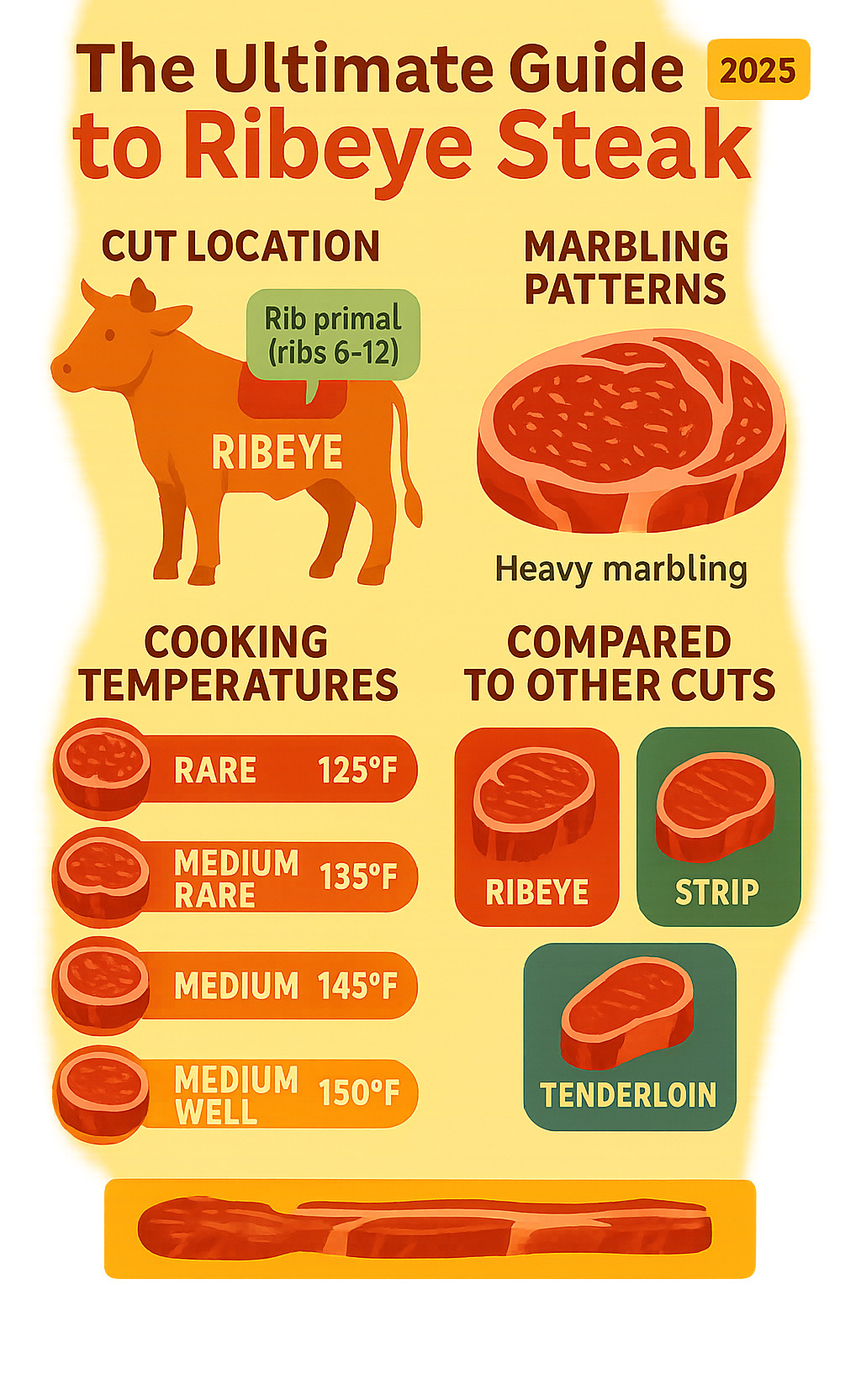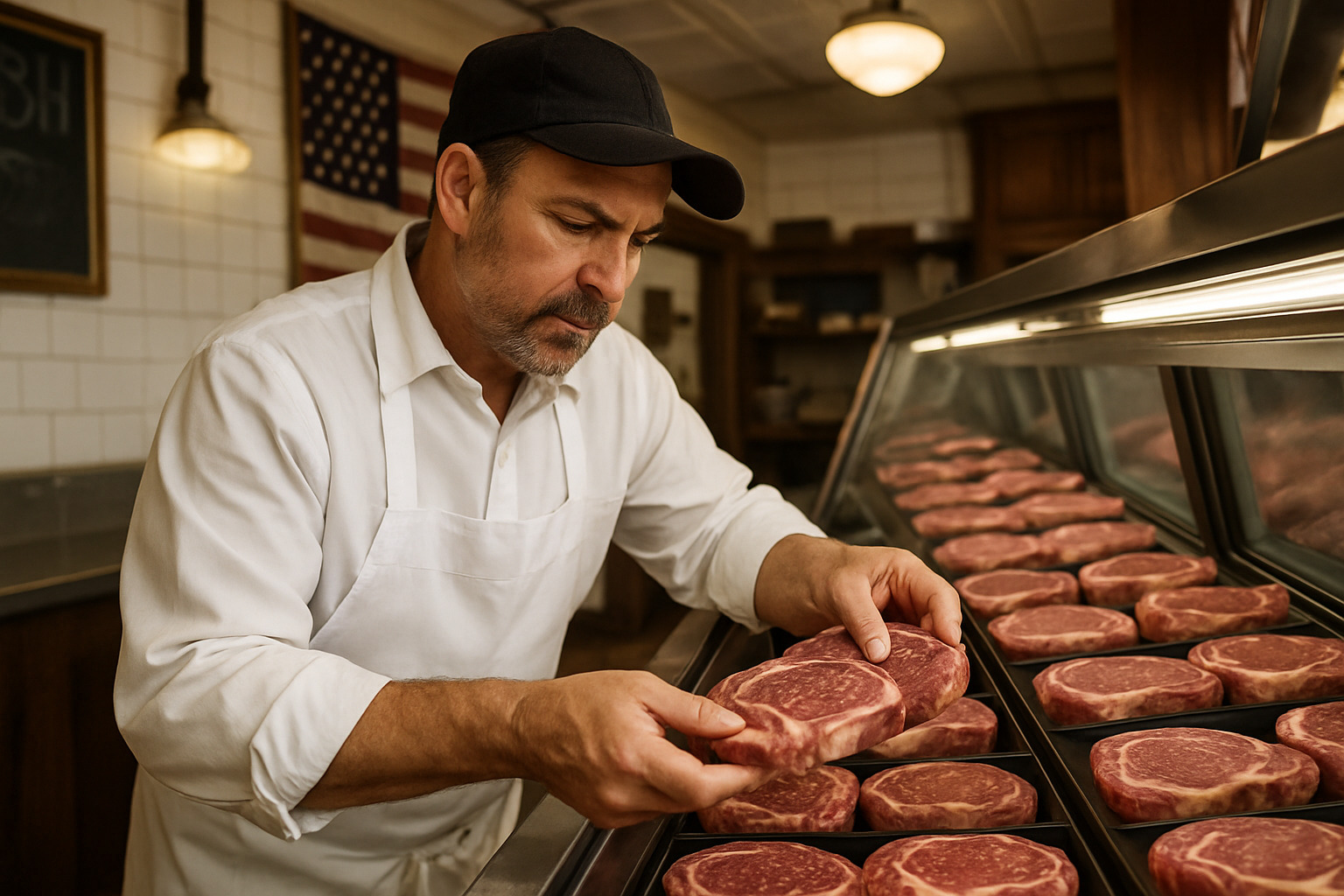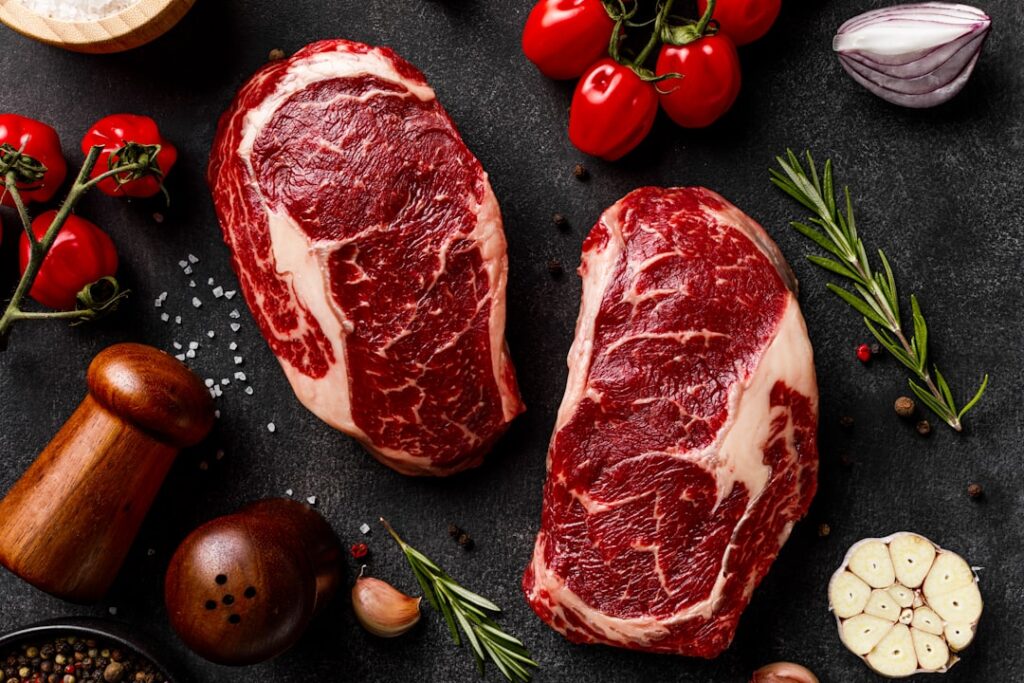Why Ribeye Steak Is the Ultimate Cut for Food Lovers
Ribeye steak is widely considered one of the most flavorful and tender cuts of beef, prized by chefs and home cooks alike for its rich marbling and juicy texture. Cut from ribs 6 through 12 of the cow, this premium steak delivers an best eating experience that makes it a favorite at steakhouses worldwide.
Quick Ribeye Steak Facts:
- Location: Cut from the rib primal (ribs 6-12)
- Flavor Rating: 5/5 for richness and beef taste
- Tenderness: 4/5 due to heavy marbling
- Best Cooking Methods: Grilling, pan-searing, broiling
- Ideal Thickness: 1 to 1½ inches
- Target Temperature: 130-135°F for medium-rare
- Average Portion: 12-14 ounces
The secret to ribeye’s incredible flavor lies in its heavy marbling – those white streaks of fat that run throughout the meat. This intramuscular fat melts during cooking, creating the rich, buttery taste that sets ribeye apart from leaner cuts like tenderloin or sirloin.
Whether you’re planning a special dinner at home or seeking the perfect steak experience during your culinary travels, understanding how to select, prepare, and cook ribeye steak will lift your dining trips. From choosing the right grade at your local butcher to mastering the perfect sear on your grill, this guide covers everything you need to know.
As one former steak competition judge put it: “This is the cut that sparked my love affair with really great steaks and the craft of butchery in general.” That passion for ribeye is shared by food lovers everywhere who appreciate its perfect balance of flavor and tenderness.

Ribeye steak vocab to learn:
What Is Ribeye Steak & Its Unique Anatomy

When you bite into a perfectly cooked ribeye steak, you’re experiencing one of nature’s most delicious accidents. This incredible cut comes from the rib primal section of the cow – specifically from ribs 6 through 12 – where the muscles had a pretty easy life just supporting the animal’s frame.
Unlike the hardworking leg muscles that become tough cuts, the rib primal muscles spent their time relaxing under the backbone. This laid-back lifestyle means less connective tissue and more of that beautiful marbling we love so much. In the meat industry, this boneless beauty is officially known as IMPS 1112A, but most of us just call it heaven on a plate.
The magic happens because these muscles weren’t constantly moving around. Instead of developing tough fibers, they accumulated fat in gorgeous white streaks throughout the meat. When you cook a ribeye steak, this marbling melts and bastes the meat from the inside out, creating that rich, buttery flavor that makes your taste buds sing.
Ribeye Steak Anatomy 101
Think of ribeye as a delicious puzzle made of three main pieces, each bringing its own personality to your plate.
The eye muscle (or longissimus dorsi if you want to get fancy) makes up the biggest part of your steak. This is the star of the show – consistently marbled, tender, and reliable. When you see that classic oval shape on your plate, you’re looking at the eye.
Then there’s the cap muscle (spinalis), and oh boy, this is where things get exciting. This crescent-shaped piece wraps around the eye like a flavorful hug. Many steak lovers consider the cap the best part of the entire ribeye steak because it’s incredibly well-marbled and has a slightly different, more intense flavor. Some butchers even sell ribeye caps separately as a premium cut.
The third player is the complexus, a smaller muscle that sometimes appears at one end. Don’t worry if your steak doesn’t have it – some butchers trim it off because it can cook a bit differently than the rest of the meat.
Finally, there’s the fat cap on the outside edge. While some people trim this off, leaving about a quarter-inch actually helps protect your steak during cooking and adds extra richness. These tenderness factors work together to create the perfect eating experience that makes ribeye so special.
Global Names for Ribeye Steak
Here’s something fun – ribeye steak is like a world traveler with different names in every country it visits. In France, they call it entrecôte, which literally means “between the ribs” (pretty clever, right?). Head down to Australia or New Zealand, and you’ll hear it called Scotch fillet.
South American steak lovers know it as ojo de bife in Argentina – that’s “eye of beef” in Spanish, which makes perfect sense when you think about it. Chileans prefer lomo vetado, referring to those beautiful marbled streaks. Up in Quebec, French-Canadians call it faux filet.
In some American steakhouses, you might see it listed as Spencer steak, named after a hotel that helped popularize this cut. And if you’re dining in Austria, look for rostbraten on the menu.
All these names, all these cultures, but they’re all talking about the same incredible cut of meat. It’s pretty amazing how good food brings the world together, isn’t it?
| Cut | Flavor | Tenderness | Fat Content | Best For |
|---|---|---|---|---|
| Ribeye | 5/5 | 4/5 | High | Grilling, pan-searing |
| Strip Steak | 4/5 | 4/5 | Medium | Versatile cooking |
| Tenderloin | 3/5 | 5/5 | Low | Special occasions |
How to Choose, Store & Age Your Ribeye

Walking into a butcher shop or meat counter can feel overwhelming, but choosing the perfect ribeye steak becomes simple once you know what to look for. The quality of your raw steak makes all the difference between a good dinner and an unforgettable meal.
Start with understanding USDA grades, which tell the story of marbling and flavor. USDA Prime represents the top 2% of beef with the heaviest marbling – it’s what high-end steakhouses serve. USDA Choice offers excellent quality that most home cooks love, with good marbling at a more reasonable price. USDA Select has less fat but still delivers tenderness when cooked properly.
Don’t overlook alternatives like AAA Alberta beef, which is wet-aged between 14-40 days. Industry experts note this offers “a great choice when looking for a less expensive option that is sure to impress.” Sometimes the best ribeye steak doesn’t come with the highest price tag.
The thickness matters more than you might think. Aim for steaks that are 1 to 1½ inches thick – any thinner and you’ll struggle to get a good sear without overcooking the inside. Thicker cuts give you more control over doneness and create that perfect contrast between crusty exterior and juicy center.
Smart Buying Checklist
Your eyes and nose are your best tools when selecting ribeye. Look for bright red meat with white or cream-colored fat – avoid anything that looks gray or brown around the edges. The marbling should be evenly distributed throughout the steak like tiny rivers of fat, not clumped together in big pockets.
Give it a sniff if possible. Fresh ribeye steak should smell clean with just a hint of metallic scent. Any sour or funky odors mean it’s past its prime and should be avoided.
Your butcher is your secret weapon here. Ask about the steak’s source, how long it’s been aged, and their cooking recommendations. Quality butchers hand-cut steaks to order and genuinely want you to have a great meal. They might even let you see different options before deciding.
For those interested in sustainable options, look for grass-fed, local, or certified humane labels. Grass-fed ribeye may have slightly less marbling than grain-fed, but it offers unique flavor profiles and environmental benefits that many food lovers appreciate. More info about Farm-to-Table Experiences can help you understand these sustainable sourcing options better.
Aging for Extra Flavor
Aging transforms good beef into exceptional beef through natural processes that concentrate flavors and break down tough fibers. Think of it as letting time do the work that no amount of seasoning can accomplish.
Dry aging takes 21-45 days and involves hanging beef in carefully controlled temperature and humidity conditions. The exterior develops a dark crust that gets trimmed away, leaving behind meat with intense, nutty flavors that taste almost like a different cut entirely. Dry-aged ribeye steak costs significantly more, but the flavor concentration is remarkable.
Wet aging is more common and affordable, taking 14-40 days with vacuum-sealed steaks aging in their own juices. While less dramatic than dry aging, this process still improves tenderness and develops deeper flavors naturally without any mechanical tenderizing.
For home storage, vacuum-sealed ribeye keeps in the freezer for up to 12 months or in the refrigerator for 3-5 days. Always thaw frozen steaks in the refrigerator for 24 hours before cooking – rushing this step with warm water or microwave thawing can ruin the texture you paid good money for.
Mastering Ribeye Cooking Methods & Doneness
There’s something magical about hearing that perfect sizzle when a ribeye steak hits a hot grill or pan. That sound signals the start of the Maillard reaction – the chemical process that creates the golden-brown crust we all crave. This reaction kicks in around 280°F, changing proteins and sugars into complex flavors that make your mouth water.
The secret to perfect ribeye steak lies in mastering high-heat searing while keeping the interior juicy and tender. Scientific research on beef marbling confirms what steak lovers have known for generations – those beautiful fat streaks don’t just look pretty, they create incredible flavor and texture when cooked properly.
Temperature precision makes all the difference. While the FDA recommends 145°F for food safety, most steak enthusiasts target 130-135°F for medium-rare to open up ribeye’s full potential. Here’s where an instant-read thermometer becomes your best friend – no more guessing games or overcooked disappointments.
Don’t forget about carryover cooking. Your steak continues cooking even after leaving the heat, typically rising another 5°F during rest time. Pull your ribeye when it’s 5°F below your target temperature, and you’ll hit that perfect doneness every time.
Ribeye Steak Grilling Guide
Nothing beats the primal satisfaction of grilling a perfect ribeye steak outdoors. Fire up your grill to a blazing 500-600°F – hot enough that you can only hold your hand over the grates for 2-3 seconds before pulling away.
Gas grills offer convenience and steady heat control, perfect for beginners mastering their technique. Charcoal brings that distinctive smoky flavor that makes your neighbors peek over the fence with envy. For the ultimate experience, try wood-fired grilling with oak for mild smoke or mesquite for bold, intense flavor.
The two-zone method works beautifully for thicker steaks. Create a scorching hot zone for searing and a medium zone for gentle finishing. This prevents the dreaded black-outside, raw-inside disaster that haunts many home grillers.
For a 1-inch ribeye steak, start with a 2-minute sear on each side over high heat to develop that gorgeous crust. Then move to medium heat and cook 4-5 minutes per side until your thermometer reads 130°F. The timing might vary based on your grill’s personality – yes, every grill has one!
Pro tip: oil your steak, not the grates. This prevents smoke-point drama and gives you better control. And please, resist the urge to press down on your steak with a spatula – you’re literally squeezing out the juices that make ribeye so special.
Pan-Sear & Oven Finish
Sometimes the weather doesn’t cooperate, or you simply prefer cooking indoors. The cast-iron skillet method delivers restaurant-quality results that rival any steakhouse in New York City.
Start by preheating your oven-safe cast-iron pan in a 450°F oven. This ensures even heat distribution and prevents temperature drops when you add the cold steak. Move the hot pan to your stovetop over high heat, then sear your ribeye steak for 2-3 minutes per side until beautifully browned.
Return the pan to the oven for 6-7 minutes to finish cooking. During the final moments, add a generous pat of butter along with fresh garlic and thyme for an aromatic finish that’ll make your kitchen smell like a five-star restaurant.
The butter basting technique takes things to the next level. Tilt your pan slightly and spoon the foaming butter over the steak repeatedly for 30-60 seconds. This creates an incredibly rich, golden crust that’s simply irresistible.
Sous Vide & Reverse Sear for Thick Cuts
For those who love precision cooking, sous vide eliminates all guesswork from ribeye steak preparation. Set your water bath to exactly your desired final temperature: 129°F for perfect medium-rare, 135°F for medium, or 122°F if you’re brave enough for rare.
Here’s a crucial safety note: steaks cooked under 130°F should never exceed 2½ hours in the water bath. Food safety isn’t negotiable, even for the perfect steak.
After your sous vide session, pat the steak completely dry and sear it in a blazing hot pan for 1-2 minutes per side. This creates the textural contrast that makes every bite interesting – tender interior with a crispy, flavorful crust.
The reverse sear method achieves similar results using conventional equipment. For thick steaks over 2 inches, cook in a 250°F oven until the internal temperature reaches 10-15°F below your target. Rest the steak, then sear in a smoking hot skillet for about a minute per side.
This gentle approach prevents overcooking and eliminates the need for extended resting since the juices stay evenly distributed throughout the meat. It’s particularly brilliant for those impressive 2-inch thick ribeyes that make such a statement on the dinner table.
Seasoning, Resting, Serving & Pairings

The magic of ribeye steak happens not just during cooking, but in those final moments when you season, rest, and serve this incredible cut. These finishing touches transform a good steak into an unforgettable meal that rivals the best steakhouses.
Here’s the beautiful truth about ribeye: it has incredible flavor all on its own and needs only salt and pepper in most cases. The rich marbling and natural beef taste shine brightest with simple seasoning. But that doesn’t mean you can’t get creative when the mood strikes.
The key to perfect seasoning is timing. Apply your kosher salt and freshly cracked black pepper when the steak reaches room temperature, about 20-30 minutes before cooking. For even deeper flavor penetration, you can salt up to 12 hours in advance – this technique draws out moisture initially, then the salt dissolves and gets reabsorbed along with the concentrated flavors.
Ribeye Steak Flavor Boosters
A light olive oil coating helps seasonings stick and prevents your ribeye steak from sticking to the grill or pan. Choose high smoke-point oils like avocado or grapeseed for the best results.
Montreal seasoning brings a classic steakhouse flavor with its blend of garlic, coriander, and black pepper. Other winning combinations include smoked paprika with garlic powder and a touch of cayenne for heat, or an herb crust made with rosemary, thyme, and oregano mixed into olive oil.
Compound butter lifts any ribeye to restaurant quality. Mix softened butter with minced garlic and fresh herbs, or go bold with blue cheese butter for an indulgent finish. Place a pat on your hot steak during the resting period and watch it melt into pure deliciousness.
Don’t overlook finishing salts – a sprinkle of flaky sea salt or flavored salt after cooking provides wonderful textural contrast and flavor bursts that regular table salt can’t match.
Wood choices for grilling add another flavor dimension. Mesquite delivers intense smokiness, while oak provides milder smoke that won’t overpower the beef’s natural richness.
Resting is absolutely crucial – this isn’t optional! Allow your ribeye steak to rest for 5-10 minutes under a loose foil tent. This time lets the juices redistribute throughout the meat and allows carryover cooking to finish the job. When you’re ready to serve, slice against the grain – cutting perpendicular to the muscle fibers – to maximize tenderness.
The best steakhouse sides complement rather than compete with ribeye’s rich flavor. Loaded baked potatoes with butter and sour cream, creamed spinach, or grilled asparagus provide perfect balance. Caesar salad or a classic wedge salad with bacon cuts through the richness beautifully.
For wine lovers, bold reds like Cabernet Sauvignon, Malbec, or Syrah have the structure to stand up to ribeye’s intensity. Beer enthusiasts should reach for porters, stouts, or IPAs that can match the beef’s robust flavors.
- Steak and Eggs Benedict – slice thin over English muffins with hollandaise
- Asian-Style Lettuce Wraps – with hoisin sauce and fresh herbs
- Truffle Mac and Cheese – creamy comfort food with steak pieces
- Grilled Peach Salad – sweet fruit balances the rich meat
- Loaded Steak Nachos – perfect for casual entertaining
From Plate to Next-Day Lunch
Leftover ribeye steak is a gift that keeps giving. The key to great leftovers starts with proper storage – refrigerate cooked steak for 3-4 days in airtight containers, or freeze for up to 3 months.
Reheating requires finesse to avoid turning your premium steak into shoe leather. Use a low oven at 250°F to warm gently, or give it a quick sear in a hot skillet for 30 seconds per side. Whatever you do, avoid the microwave – it creates tough, rubbery texture that’s nothing like the original.
Transform your leftovers into steak salads by slicing thin over mixed greens with blue cheese and balsamic vinaigrette. Breakfast hash with diced ribeye, potatoes, and eggs makes weekend mornings special. Steak tacos with warm tortillas, fresh salsa, and avocado bring Mexican flair to your leftover game.
Fried rice with ribeye pieces, soy sauce, vegetables, and scrambled eggs creates an Asian-inspired meal that’s completely different from the original dinner. And who can resist cheesesteak sliders Philadelphia-style with peppers and provolone?
These creative sandwich hacks and leftover changes prove that great ribeye steak delivers value long after the initial meal. With proper technique and a little creativity, you’ll find yourself looking forward to the leftovers almost as much as the original steak dinner.

FAQs & Final Bite
Mastering ribeye steak goes beyond just cooking technique – it’s about understanding the complete picture from nutrition to sustainability. Let’s address the most common questions that arise when people find their love for this exceptional cut.
A 3-ounce serving of cooked ribeye steak contains approximately 190 calories, 10g total fat, and 23g protein. While it’s definitely an indulgent choice, it’s also packed with nutrients your body needs. You’ll get excellent amounts of protein, B vitamins, zinc, and selenium, plus good doses of iron and phosphorus.
The most common mistakes people make when cooking ribeye often stem from impatience or overthinking. Moving the steak too frequently prevents proper crust formation, while not preheating adequately leads to poor searing. Many home cooks also make the mistake of cutting into their steak immediately instead of letting it rest, which causes all those delicious juices to run out onto the plate.
Using oils with low smoke points creates unwanted flavors and smoke, while overcrowding your pan or grill prevents proper browning. Perhaps most importantly, relying on cooking times instead of internal temperature leads to inconsistent results every time.
Sustainability considerations are increasingly important for conscious food lovers. Grass-fed beef generally has a lower carbon footprint than grain-fed options, though it may have less marbling. The trade-off is worth considering – you get cleaner environmental impact and often more complex flavors, even if the texture differs slightly from grain-fed ribeye steak.
Look for local producers when possible to reduce transportation impact. Ethical sourcing includes considering animal welfare standards and regenerative farming practices that actually improve soil health over time.
For food enthusiasts in New York City and beyond, ribeye steak represents the pinnacle of beef enjoyment. Whether you’re exploring steakhouses during culinary travels or perfecting your home technique, understanding these fundamentals makes every ribeye experience better.
What internal temperature should ribeye steak reach?
The internal temperature you choose dramatically affects your ribeye steak experience. Rare at 125°F gives you a cool red center with very soft texture – some love it, others find it too raw. Medium-rare at 130-135°F hits the sweet spot for most people, delivering a warm red center that’s optimal for ribeye’s marbled fat to render properly.
Medium at 140-145°F produces a light pink center with firmer texture, while medium-well at 145-155°F leaves just a hint of pink. Well-done at 160°F and above eliminates all pink but also much of the juiciness that makes ribeye special.
Most steak experts strongly recommend medium-rare for ribeye because this temperature allows the marbled fat to melt and distribute throughout the meat while maintaining that signature richness. Cooking past medium begins to dry out the steak and diminishes what makes this cut so special in the first place.
Carryover cooking will raise the temperature about 5°F during resting, so pull your steak when it’s slightly below your target temperature.
How does ribeye steak compare to tenderloin and sirloin?
Understanding how ribeye steak stacks up against other premium cuts helps you choose the right steak for each occasion. Flavor-wise, ribeye wins decisively with its rich, beefy taste thanks to heavy marbling. Tenderloin offers mild, subtle flavor that some find bland, while sirloin falls somewhere in between.
Tenderness tells a different story – tenderloin earns its “filet mignon” reputation with butter-soft texture, while ribeye comes in a close second. Sirloin varies significantly depending on the specific cut, with some sections quite tender and others requiring more careful preparation.
Price reflects these differences – tenderloin commands premium prices for special occasions, ribeye sits in the middle-to-high range, and sirloin offers excellent value for regular meals. Versatility is where ribeye really shines, excelling at high-heat cooking methods like grilling and pan-searing. Tenderloin works beautifully for neat presentations but can disappoint those seeking bold beef flavor.
How should leftover ribeye steak be reheated?
Properly reheating leftover ribeye steak can preserve much of its original quality if you avoid common mistakes. The low oven method works best – place your steak on a wire rack over a baking sheet and heat at 250°F until warmed through, usually 10-15 minutes. This gentle approach prevents further cooking while warming evenly.
Quick skillet reheating offers another good option when you’re short on time. Heat a pan over medium heat, add a little oil, and warm the steak for 1-2 minutes per side. The key is keeping the heat moderate to avoid overcooking.
Avoid microwaving at all costs – this creates tough, rubbery texture and uneven heating that completely ruins the steak’s quality. The microwave essentially steams the meat, destroying the texture you worked so hard to achieve.
The secret to successful reheating is gentle warmth rather than aggressive heat. You’re not trying to cook the steak again, just bring it back to serving temperature while preserving its texture and flavor.
At The Dining Destination, we believe understanding premium ingredients like ribeye steak improves every culinary trip. Whether you’re planning your next food-focused trip or perfecting techniques at home, mastering ribeye opens doors to exceptional dining experiences worldwide.
Ready to explore more culinary trips? Check out our guide to the Best Culinary Experiences for your next food journey.








